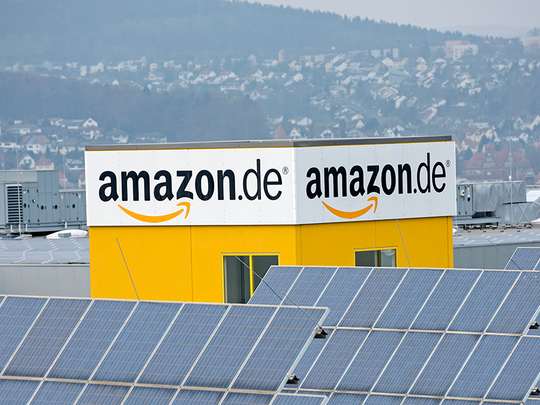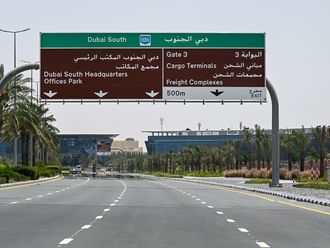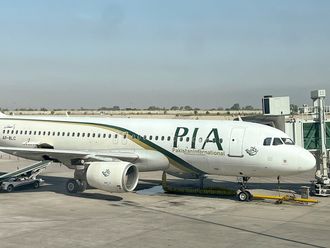
New York: Two decades after Jeffrey P. Bezos started Amazon in his Bellevue, Washington, garage, his e-commerce juggernaut could be forgiven for letting up on its rapid growth.
Not Amazon, though, which steamrolled through 2015, capturing an ever-growing share of US retail sales. Of every additional $1 Americans spent for items online this year, Amazon captured 51 cents, according to a recent estimate by Macquarie Research.
And of the expected $94 billion (Dh345.15 billion) growth in all retail sales last year - both in stores and online - Amazon took a staggering $22 billion, or almost a quarter, Ben Schachter, a retail analyst at Macquarie calculated. And the holiday shopping season served to solidify the notion that the internet is increasingly Bezos’ world and the rest of us are just shopping in it.
Amazon capped its blockbuster year by reporting what it said was a record-breaking holiday season, shipping 200 million items through its Prime subscription service, which offers free shipping and a host of other benefits. “It’s remarkable. Amazon is truly in a league of its own,” Schachter said. “It’s going to be extremely challenging for anyone else to catch up.”
Amazon’s strong results have led to a meteoric rise in its share price, which has more than doubled last year. Its market capitalisation of about $325 billion now dwarfs that of Wal-Mart’s, which shrank by a quarter to just below $200 billion.
Despite that dominance, Amazon’s actual profits are still tiny - or at least they were in the company’s most recent quarterly report in October. The company earned just $79 million on $24.5 billion in total revenue in the quarter, and leaned heavily on its surging cloud computing business, Amazon Web Services, for profit.
Amazon Web Services’ operating income was $521 million, up more than five-fold in a year. Without its cloud business, the company would have had a much more difficult time turning a net profit, something it has not often done.
And at times, Amazon has seemed to be in danger of getting trapped in a race to the bottom that it brought on with its steep discounting. “They were just trying to sell more by underpricing everybody,” said Craig Johnson, president of Customer Growth Partners, a retail consulting firm.
“But they realised they would never make any money that way. They evolved. It’s much a different company than it was five years ago.”
Maturing retail business
For one, last year’s surge has made investors increasingly confident that Amazon’s retail business is maturing, following years of heavy investment in infrastructure and logistics. Amazon has blanketed the country with more than 100 warehouses, and is building more, speeding up shipping times.
That investment is now paying off in the steady growth in users of its Prime fast-shipping membership programme, which covers an estimated 25 percent of all American households. Amazon picked up 3 million new Prime members during the third week of December alone. Some analysts estimate that half of all American households will be Prime members by 2020.
Amazon has also focused on bolstering the benefits of its Prime membership beyond free expedited shipping. It has aggressively marketed its music and video streaming offerings, and has invested in a growing catalogue of original content, including the TV series ‘Transparent’, which has won critical praise.
All the while, Amazon has continued to surprise competitors with unconventional promotional efforts. In July, typically a slow month for retailing, Amazon created a whole new sales holiday, called Prime Day, prompting Wal-Mart to match many of Amazon’s deals.
“It just keeps raising the bar,” said Traci Gregorski, vice-president for marketing at the retail research firm Market Track. “They’re driving people to their Prime service,” she said, “and once they’re hooked, they’re hooked.”
Amazon’s competitors, meanwhile, have found themselves fighting over a smaller and smaller piece of the pie. Wal-Mart, in particular, committed $2 billion to its e-commerce efforts, and announced its own subscription delivery programme. It opened four new centres dedicated to filling online orders, and its San Bruno, California-based e-commerce team has grown to more than 2,500 staff members from just 500 employees four years ago.
But its online sales still amount to less than one-sixth of Amazon’s, and they are slowing, too. In its latest quarter, e-commerce sales grew only 10 per cent from a year ago, compared with a 20 per cent rise in Amazon’s retail sales during the same period.
Overall, Amazon’s share of US e-commerce sales jumped to 26 per cent last year from 22 per cent in 2014 and 16 per cent in 2011, according to Macquarie estimates. Four per cent of all retail purchases in the US, excluding cars, gas and sales at food and beverage stores, were made through Amazon last year, double its share two years ago.
And with Amazon expanding into new segments - it introduced a crafts market to challenge Etsy, and is also trying its hand at groceries - some analysts ask: Is anybody in retailing safe?
Sellers of branded goods, like the Disney store, are still able to offer what Amazon cannot. Luxury is another area in which Amazon has little presence.
Johnson struggled to come up with further examples. Restaurants?
“You can’t eat food on the internet,” he offered. “Though with Amazon, nothing seems impossible.”











